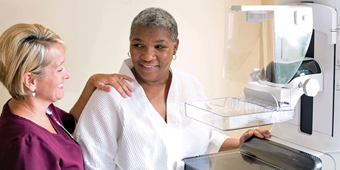Lung Cancer Screening Saves Lives

Answer a few questions and we'll provide you with a list of primary care providers that best fit your needs.
While breast cancer is the most common cancer in women in the U.S., and prostate cancer is the most common in American men, lung cancer exceeds both as the number one cancer killer in this country, according to the American Cancer Society (ACS). It accounts for about 23% of all cancer deaths.
Lung cancer is extremely difficult to detect. That’s because it shows very few signs that it has invaded the body until the cancer is quite advanced. The good news is that low-dose computed tomography for lung cancer now makes early detection possible, offering the best opportunity for treatment and recovery.
Standard Screenings
Traditionally, if a patient showed signs of lung cancer, doctors would order one of the following tests.
- Chest X-ray. This is often the first test ordered to find masses or spots on the lungs. These are commonly performed at imaging centers, hospitals and even in some doctors’ offices.
- Sputum cytology. For this test, a sample of the mucus you cough up from your lungs (sputum) is looked at under a microscope to see if it contains cancer cells.
Unfortunately, these tests usually aren’t ordered until the person shows up at the doctor’s office with symptoms. At that point, the cancer may be too advanced for treatment to be effective. Recent medical studies found that while these tests can detect lung cancer, they don’t seem to reduce the risk of death. As a result, the ACS and most doctors do not recommend using them to screen the general population — or even people at higher risk, such as cigarette smokers — for lung cancer.
Life-saving Screening
The most highly recommended weapon in the fight against lung cancer is the low-dose CT scan. In this procedure, a CT scanner rotates a thin X-ray beam around the chest in a spiral pattern, producing thin cross-sectional views of the lungs. This offers several advantages over standard CTs and chest X-rays:
- It uses less radiation.
- It does not require the injection of contrast agents into the patient’s blood to enhance the images.
- It is more sensitive at detecting lung cancer.
- The tumors found are generally smaller, increasing the chance that they can be removed surgically.
The National Lung Screening Trial showed that low-dose CT screening used to screen high risk individuals led to a 20 percent rate reduction in the number of lung cancer deaths, compared to screening with a standard chest X-ray.
The good news is that a new screening method for lung cancer now makes early detection possible
There are some downsides. Low-dose CT is so sensitive that it detects many abnormalities that turn out not to be cancer, but still need further testing to be sure. This may lead to anxiety and possibly unnecessary tests, such as more CT scans, or even more invasive procedures such as biopsies or surgery in some people. Lung cancer screening may find a lung cancer that would have never caused symptoms or harmed you in your lifetime if the cancer had not been found. And while the radiation exposure is less than with chest X-rays, patients are still exposed to a small amount.
Who Should Be Screened
Your primary care doctor can help you decide if lung cancer screening is right for you.
The U.S. Centers for Medicare & Medicaid Services is the agency within the U.S. Department of Health and Human Services (HHS) that administers the nation’s major healthcare programs. They advise lung cancer screening for people who are 50 to 77 years old and:
- Do not have any signs or symptoms of lung cancer
- Have not had lung cancer before
- Currently smoke or quit less than 15 years ago
- Have a 20-pack-year smoking history (smoke one pack per day for 20 years or two packs a day for 15 years).
A physician referral is required. Check with your insurance provider before scheduling an exam to confirm whether your provider covers this cost.
If your screening shows something of concern, you may be referred to a Lung Nodule Evaluation Program. The Lung Nodule Evaluation Program may provide an extra layer of monitoring for lung cancer. It reviews imaging that has been ordered for a wide range of reasons and monitors spots on the lungs. A team of experts then determines whether the nodules require follow-up monitoring or treatment.
What About Genetic Testing?
The most significant advances in genetic screening for lung cancer focus on testing tumor tissue once lung cancer has already been diagnosed. People most likely to benefit from this “biomarker” testing are those with a subtype of non-small cell lung cancer called adenocarcinoma.
Scientists look for abnormalities in the tumor’s DNA and specific protein levels. These biomarkers can provide important information about what causes the tumor to grow, and doctors can consider whether a targeted therapy exists that may slow tumor growth or shrink the tumor. Additional testing of a specific protein may help predict if a patient would benefit from immunotherapy, which uses substances that boost a person’s own immune response to fight the cancer.
It's easy to get the care you need.
Answer a few questions and we'll provide you with a list of primary care providers that best fit your needs.
Source: American Cancer Society; National Cancer Institute, National Institutes of Health; Centers for Disease Control; U.S. Centers for Medicare and Medicaid




